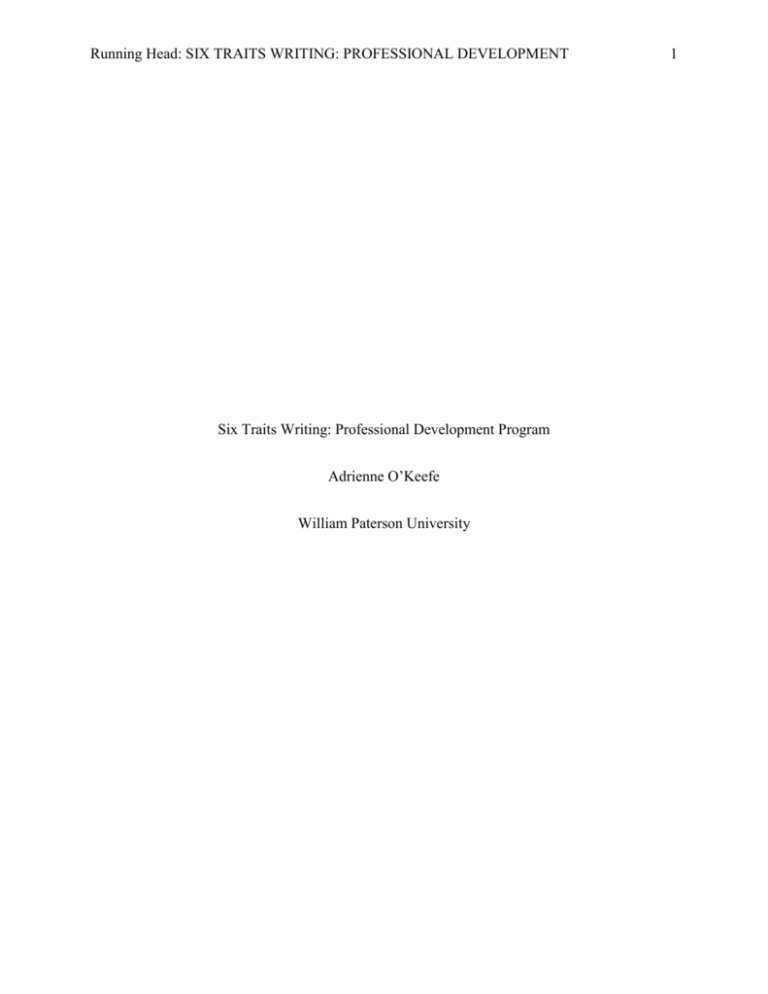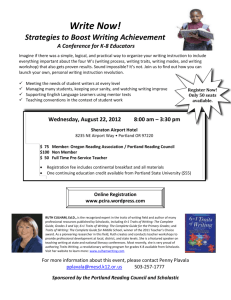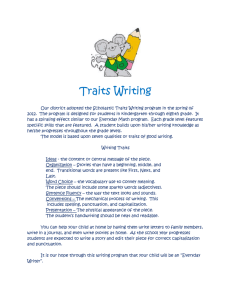File
advertisement

Running Head: SIX TRAITS WRITING: PROFESSIONAL DEVELOPMENT Six Traits Writing: Professional Development Program Adrienne O’Keefe William Paterson University 1 SIX TRAITS WRITING: PROFESSIONAL DEVELOPMENT 2 Introduction As an elementary school principal, my professional development initiative will be focused on increasing literacy in our school by implementing a 6 traits writing program school wide. This program enables teachers to develop a common understanding and vocabulary of what good writing is in various forms. The traits are “a powerful tool for communication about writing performance, one that far exceeds the limited information a single grade or score provides.” (Culham, 2003, p. 12) Using these criteria, teachers in kindergarten to grade 12 will have a shared view of what good writing looks like and time is saved as we no longer need to review and revise curriculum year after year. With this new approach, teachers will be able to provide specific and direct feedback to students that will encourage them to grow as writers and self evaluate (p. 13). The six traits include: ideas, organization, voice, word choice, sentence fluency, and conventions. Ideas are the content of the writing, or “the heart of the message” (p. 11). Organization is how the piece is structured, or “the logical pattern of ideas” (p. 11). Voice is what makes the writer’s style unique, or “how his or her feelings and convictions come out through the words.” (p. 12) Word choice is in the inclusion of rich, vivid, and precise language. Sentence fluency is the flow of the piece, “the way the writing plays to the ear” (p. 12). Conventions are using correct spelling, grammar, and general mechanics. A huge advantage of this program is its flexibility. It isn’t a replacement for any current writing curriculum, rather it is “an assessment tool that works in concert with the curriculum to guide instruction so all students can successfully meet their writing goals.” (p. 19) In this professional development program, classroom teachers will be introduced to practical strategies to implement the 6 traits into their current writing practices in the classroom. Content area teachers will also learn how this common vocabulary can be used in their instruction to create strong interdisciplinary SIX TRAITS WRITING: PROFESSIONAL DEVELOPMENT 3 lessons. Teachers will be asked to implement specific strategies and complete written reflections to assess the lesson’s success. Since assessment is a main focus of this writing program, teachers will also assess student samples of writing in collaborative groups using the six traits and analyze student work comparatively. Supporting Materials Bailey, J., (2009). Practical Strategies for Using Six Traits in Your Writing Instruction. Bellevue: Bureau of Education and Research. Culham, R., (2003). 6+1 Traits of Writing: The Complete Guide Grades 3 and Up. New York: Scholastic Professional Books. Culham, R., (2006). 100 Trait Specific Comments. NewYork: Scholastic. Culham, R., (2009). Daily Trait Warm Ups. New York: Scholastic. Culham, R. & Wheeler, A., (2003). Writing to Prompts in the Trait Based Classroom: Content Areas. New York: Scholastic. Culham, R. & Wheeler, A., (2003). Writing to Prompts in the Trait Based Classroom: Literature Responses. New York: Scholastic. Culham, R. & Wheeler, A., (2003). 40 Reproducible Forms for the Writing Traits Classroom. New York: Scholastic. Culham, R., (2004). Using Picture Books to Teach Writing With the Traits. New York: Scholastic. SIX TRAITS WRITING: PROFESSIONAL DEVELOPMENT 4 Helpful Websites: Information regarding books lists, workshops, research supporting the 6 traits, updated news about 6 traits http://www.culhamwriting.com/mainstreet.html http://teacher.scholastic.com/products/ruth-culham-writing-program/ Timeline/Itinerary September 2 Hour Session: Introduction, Ideas, Organization, Word Choice Introduction PowerPoint: Define 6 Traits Writing, Then and Now Writing Sample, “The Important Thing About the Traits” Ideas: Daily Warm-Up (Culham, 2009, p. 12), “Show Me, Don’t Just Tell Me”, Seed Idea List (Bailey, 2009, p. 11), Snap Shot (Bailey, 2009, p. 17) Organization: Daily Warm-Up (Culham, 2009, p. 35), Transition Words (Bailey, 2009, p. 33), “Talk to the Hand” Paragraphing (Bailey, 2009, p. 34), Research Notes and Packet (Bailey, 2009, p. 40 & 42), Share Student Leads, Organizational Options, Writing Conclusions Word Choice: Daily Warm-Up (Culham, 2009, p. 80), Stop Using Overused Words, Strengthen Sentences (Bailey, 2009, p. 61), Describe it, Then Build it, Rice Cakes or Salsa November 2 Hour Session: Voice, Sentence Fluency, Conventions Think Pair Share: Reflection on Success of Implemented Strategies and Lessons SIX TRAITS WRITING: PROFESSIONAL DEVELOPMENT 5 Voice: Daily Warm-Up (Culham, 2009, p. 65), Whose Voice is it Anyway? (Bailey, 2009, p. 67), Learning to Hear Voice in Literature (Culham, 2003, p. 129-130), Act it Out Sentence Fluency: Daily Warm-Up (Culham, 2009, p. 98), Using Highlighters, Mixed Up Sentences (Bailey, 2009, p. 75), Slinky City Conventions: Daily Warm-Up (Culham, 2009, p. 161), Color Pencil Editing, Instant No Excuse Words (Bailey, 2009, p. 80), Take it Out, Conventions Center, “Schoolhouse Rock” January 2 Hour Session: Using Picture Books to Teach Traits Think Pair Share: Reflection on Success of Implemented Strategies and Lessons Ideas: Book List (Culham, 2004, p. 15-26), The Secret Knowledge of Grown Ups (p. 27) Organization: Book List (Culham, 2004, p. 38-49), Click, Clack, Moo: Cows That Type (p. 54-55) Voice: Book List (Culham, 2004, p. 62-74), Wolf! (p. 78-79) Word Choice: Book List (Culham, 2004, p. 87-97), The Wolf Who Cried Boy (p. 98-99) Sentence Fluency: Book List (Culham, 2004, p. 108-117), The Important Book (p. 120121) Conventions: Book List (Culham, 2004, p. 129-133), Punctuation Takes a Vacation (p. 127-128) March 2 Hour Session: Assessing Student Work Using the Traits SIX TRAITS WRITING: PROFESSIONAL DEVELOPMENT 6 Think Pair Share: Reflection on Using Picture Books to Teach the Traits Five Point Scoring Rubric (Culham, 2003, p. 12 & 15) Trait Specific Comments: Culham, R., (2006). 100 Trait Specific Comments. NewYork: Scholastic. Small groups assess writing samples provided by text (Culham, 2003, p. 48, 45, 42, 81, 111, 152, 155, 189, 192, 230) Small groups assess their own class’s writing samples May 2 Hour Sessions: Using the Traits for Literature Response and in the Content Areas Think Pair Share: Reflection on Writing Assessment Using the Traits Writing RAFTS (Role, Audience, Format, Topic, Strong Verb) Prompts: Literature Response (Culham, 2003, p. 16-17), Frindle (p. 23) RAFTS Math Prompts: Real Life Algebra (Culham, 2003, p. 20) RAFTS Social Studies Prompts: Human Rights (Culham, 2003, p. 48-49) RAFTS Science Prompts: The Water Cycle (Culham, 2003, p. 57) Write RAFTS prompts based on current science, math, and social studies curriculum Surveymonkey Professional Development Survey SIX TRAITS WRITING: PROFESSIONAL DEVELOPMENT 7 Detailed Descriptions of Activities “Show Me, Don’t Just Tell Me”: Students rewrite nonspecific, telling statements using showing details. Examples include: Frogs are interesting, my friends are nice, or the roller coaster was scary. (Culham, 2003) Students share examples of strong leads. Strategies include: thought provoking question, funny story, personal anecdote, list of main points, eye opening statement, expert quotation, student’s own angle. (Culham, 2003) Organizational Options: Students can organize the middle of the paper in different ways, including: by space, by time, by content, or by perspective. (Culham, 2003) Writing Conclusions: Students can wrap up their paper using some of these strategies: a profound thought, a surprise, a quote, a tie up, a question, an open ended statement, a challenge, a summary, a literary device, or a laugh. (Culham, 2003) Stop Using Overused Words: Students generate a list of overused words in collaborative groups. Using a thesaurus and their background knowledge of vocabulary they design a stop sign with stronger synonyms of the overused word. Describe it, Build it: Divide the class into two groups. Distribute the same set of building materials. Students will construct an object and write a description of how they built the object and their final product. The groups will then attempt to replicate each other’s objects. Using detailed and descriptive language will enable them to succeed. (Culham, 2003) SIX TRAITS WRITING: PROFESSIONAL DEVELOPMENT 8 Rice Cakes or Salsa?: Overused, bland vocabulary is referred to as rice cake, and more interesting vocabulary is referred to as salsa. (Culham, 2003) Act it Out: Students are given a list of voice descriptors. Just like in charades, a student will act out the descriptor. This is help students see how different voices can be represented or portrayed. (Culham, 2003) Using Highlighters for Sentence Fluency: Students highlight the first few words of all the sentences in a piece of writing. This will help them notice if they frequently begin sentences the same way. (Bailey, 2009) Slinky City: Read short, medium, and longer length sentences to the students. Have them use a slinky to demonstrate the length of the sentence. This hands-on activity will help them visualize sentence length and make an auditory connection to varying sentence lengths. (Culham, 2003) Color Pencil Editing: Students use different colored pencils for different editing marks while revising work. (Bailey, 2009) Take It Out: Eliminate all punctuation, capitalization, and indentation from a piece of writing. Students must add the elements correctly back into the writing so it makes sense. (Culham, 2003) Conventions Center: Choose students to be experts in certain areas of the conventions. Make signs for their desks. When classmates have questions when editing, they can ask the experts for their assistance. (Culham, 2003) SIX TRAITS WRITING: PROFESSIONAL DEVELOPMENT 9 Schoolhouse Rock: See below for a link to the Schoolhouse Rock You Tube videos. Many grammatical concepts are featured in these videos. (http://www.youtube.com/results?search_query=schoolhouse+rock&oq=schoolhouse+roc k&gs_l=youtube.3...0.0.0.4138.0.0.0.0.0.0.0.0..0.0...0.0...1ac.) Conclusion Through using 6 traits writing instruction and assessment in our elementary school, we hope to see an increase in our student’s confidence, comfort, and performance in both writing and written reading response. After a significant amount of time using this common vocabulary, we hope to see an increase in our NJASK Writing and Reading Open Ended responses in grades 3 through 5. Through adding these strategies to our curriculum, we also hope to foster a passion for teaching writing in our staff and a passion for the written word in our students. SIX TRAITS WRITING: PROFESSIONAL DEVELOPMENT 10 References Bailey, J., (2009). Practical Strategies for Using Six Traits in Your Writing Instruction. Bellevue: Bureau of Education and Research. Culham, R., (2003). 6+1 Traits of Writing: The Complete Guide Grades 3 and Up. New York: Scholastic Professional Books. Culham, R., (2006). 100 Trait Specific Comments. NewYork: Scholastic. Culham, R., (2009). Daily Trait Warm Ups. New York: Scholastic. Culham, R. & Wheeler, A., (2003). Writing to Prompts in the Trait Based Classroom: Content Areas. New York: Scholastic. Culham, R. & Wheeler, A., (2003). Writing to Prompts in the Trait Based Classroom: Literature Responses. New York: Scholastic. Culham, R. & Wheeler, A., (2003). 40 Reproducible Forms for the Writing Traits Classroom. New York: Scholastic. Culham, R., (2004). Using Picture Books to Teach Writing With the Traits. New York: Scholastic. SIX TRAITS WRITING: PROFESSIONAL DEVELOPMENT 11









